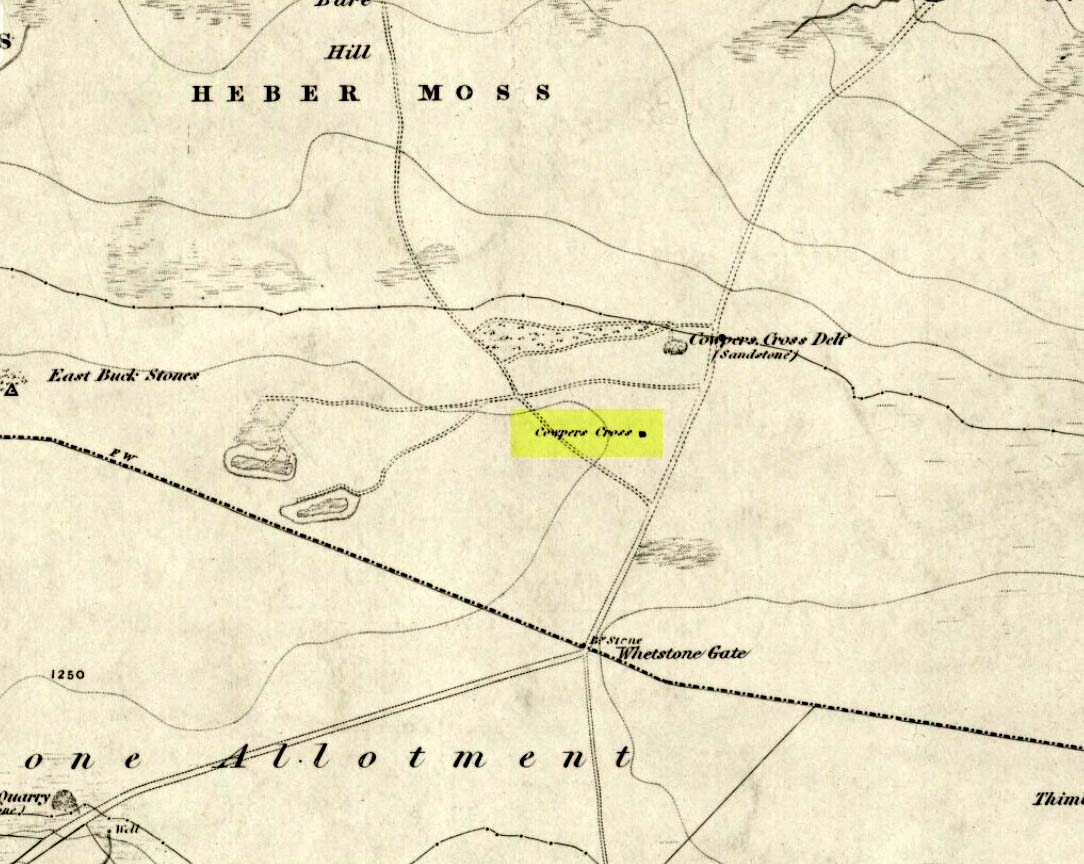Cross: OS Grid reference – SE 10223 45609
Also Known as:
- Cawper’s Cross

From Ilkley town, head up the road as if you’re going to White Wells but keep following the moorland road up towards Whetstone Gate and the TV masts on the very tops (you’ll have to walk the last half-mile). Shortly before you get them, you can’t miss this relic by the track-side on your right-hand side.
Archaeology & History
Possibly a christianised monolith, but more likely an original site, put here in an attempt to make local people stop going to the Badger Stone for regular spring gatherings. However, there was until recently what looked like an old monolith on the ground a few yards away, which may have stood upright before the cross was erected. Also on the south-facing side of the cross were four cup-markings, indicating great age. These may also have been added when the cross was erected. (We know this occurred at other sites in the region, e.g., Churn Milk Joan, Midgley Moor, where such cup-marks were added sometime in the 15th or 16th century.) However, thanks to some idiotic halfwits in more recent years going up here and vandalizing Cowper’s Cross, the prehistoric cup-markings that were on this relic have been destroyed. The upright shaft of the cross that’s here now is a re-worked gatepost that replaced the old shaft with its authentic ‘pagan’ carvings.

But it’s had other bits of bad luck through the years. The site was struck by lightning many years back, splitting the stone in half, but has since been rebuilt and stands adjacent to its original position, right next to the old Roman road that crosses Ilkley Moor. Historian Allan Butterfield suggested this site to have originally been an old boundary markstone, christianised many centuries ago. The name ‘Cowper’ derives from the local Ilkley family of Cawper.
Those of you interested in the early christian history of these moors should also have a look at the little-known Black Knoll Cross, less than a mile south of here in the middle of Morton Moor.
Folklore
Folklore relates that markets were held at this old stone cross many years ago. This gives added weight to the idea that the nearby cup-and-ring marked Badger Stone, where markets were probably held around the time of the equinoxes, was the original site for such gatherings.
Note that another site, the Reva Hill Cross, on the eastern side of this moor, has much the same history.
References:
- Bennett, Paul, The Old Stones of Elmet, Capall Bann: Chieveley 2001.
- Cowling, E.T., Rombald’s Way, William Walker: Otley 1946.
© Paul Bennett, The Northern Antiquarian
The map could not be loaded. Please contact the site owner.
There are only one kind of people who would destroy a Christian symbol. Enough said.
Hi Mark – Yeah, I know what y’ mean. The uneducated, uncaring sort of people who destroyed (and still do) pre-christian, or Buddhist, or Muslim, or Hindu sacred sites are the same psychological types who sadly disrespect our living world and megalithic sites, deluded by their own lack of clear insight. Such are some sad aspects of the human world…..
That is sad to hear.